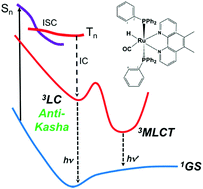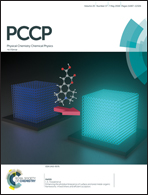Thermal equilibration between excited states or solvent effects: unveiling the origins of anomalous emissions in heteroleptic Ru(ii) complexes
Abstract
In this manuscript we present a computational study on the photoluminescence properties of several heteroleptic [Ru(H)(CO)(N^N)(tpp)2]+ complexes (tpp = triphenylphosphine). A special focus is set on disentangling the temperature-dependent emissive properties. Experimentally, when cooling a solution of [Ru(H)(CO)(dmphen)(tpp)2]+ (dmphen = 5,6-dimethyl-1,10-phenanthroline) from room to cryogenic temperature, a partial emission switch from metal-to-ligand charge transfer (3MLCT) to ligand-centered (3LC) phosphorescence is observed, resulting in dual photoluminescence. Two different origins of the anomalous emissions are possible, i.e., thermal equilibration between electronically excited states or different excited state solvent relaxation effects. Our calculations are in favor of the thermally equilibrated scenario. This computational investigation highlights the importance of controlling the temperature-dependent emissive behavior for optoelectronic applications.

- This article is part of the themed collection: 2018 PCCP HOT Articles


 Please wait while we load your content...
Please wait while we load your content...